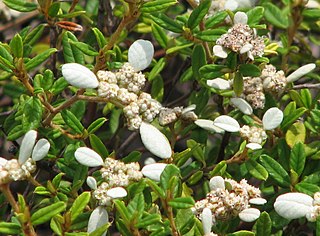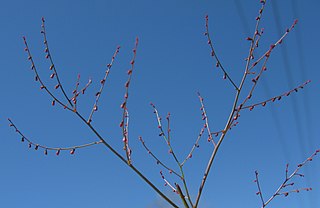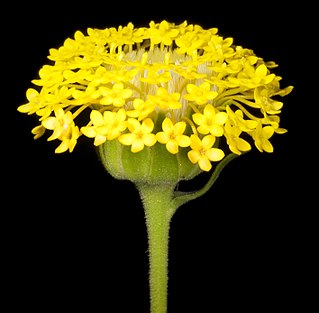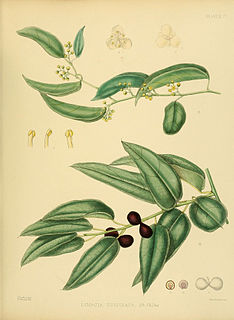
Terminalia is a genus of large trees of the flowering plant family Combretaceae, comprising nearly 300 species distributed in tropical regions of the world. The genus name derives from the Latin word terminus, referring to the fact that the leaves appear at the very tips of the shoots.

Casuarina is a genus of 17 tree species in the family Casuarinaceae, native to Australia, the Indian subcontinent, southeast Asia, islands of the western Pacific Ocean, and eastern Africa. It was once treated as the sole genus in the family, but has since been split into four genera.

Hakea is a genus of about 150 species of plants in the Family Proteaceae, endemic to Australia. They are shrubs or small trees with leaves that are sometimes flat, otherwise circular in cross section in which case they are sometimes divided. The flowers are usually arranged in groups in leaf axils and resemble those of other genera, especially Grevillea. Hakeas have woody fruit which distinguishes them from grevilleas which have non-woody fruit which release the seeds as they mature. Hakeas are found in every state of Australia with the highest species diversity being found in the south west of Western Australia.

Calandrinia are a large genus of flowering plants known as purslanes and redmaids. It includes over 100 species of annual and perennial herbs which bear colorful flowers in shades of red to purple and white. Plants of this genus are native to Australia, western South America, Central America, and western North America. Some species have been introduced to parts of New Zealand, southern Africa, Asia, and Europe.

Ricinocarpos is a plant genus of the family Euphorbiaceae first described as a genus in 1817. The entire genus is endemic to Australia.

Maireana is a genus of around 57 species of perennial shrubs and herbs in the family Amaranthaceae which are endemic to Australia. Species in this genus were formerly classified within the genus Kochia. The genus was described in 1840 by the botanist, Moquin-Tandon and named to honour Joseph François Maire (1780-1867), an amateur botanist who befriended him during the author's first visit to Paris in 1834.

Spyridium is a genus of plants in the family Rhamnaceae. It includes about 30 species found in southern Australia.

Conostylis is a genus of perennial herbs in the Haemodoraceae family, commonly known as cone flowers. All species are endemic to the south west of Western Australia.

Hemigenia is a genus of flowering plants in the mint family, Lamiaceae and is endemic to Australia where most species occur in Western Australia, although some are also found in New South Wales and Queensland. Plants in this genus are shrubs or bushes with simple leaves and tube-shaped flowers with the petals forming two "lips" - the upper one with two lobes and the lower one with three.

Gonocarpus (raspwort) is a genus of flowering plants in the family Haloragaceae. The species, which are native to Australia, New Zealand and Malesia, include:

Podotheca is a genus of flowering plants in the pussy's-toes tribe (Gnaphalieae) within the Asteraceae. All species are endemic to Western Australia, except for Podotheca angustifolia which occurs across the south of Australia.

Tetracera is a genus of flowering plants of the Dilleniaceae family; several species are lianas.
Cyanothamnus is a genus of flowering plant in the family Rutaceae, native to Australia.

Gunniopsis is a genus of flowering plants in the iceplant family, Aizoaceae. These plants are found in areas of inland Australia.

Roepera is a genus of flowering plant in the family Zygophyllaceae. It is native to southern Africa and Australia.

Huberantha is a genus of plants in the family Annonaceae and tribe Miliuseae. It is distributed in Australia, tropical Asia, East Africa and some Pacific islands. Tanawat Chaowasku named the genus "Huber's flowers" in honor of the German botanist Herbert Huber and to highlight its flowers as a distinguishing feature of the genus. A number of species have been moved here from the genus Polyalthia.

Tinospora is a genus of succulent woody climbing shrubs. Thirty-four species are currently recognized. Species generally send down long aerial roots from host trees. They have corky or papery bark. They are found in tropical and sub-tropical parts of Asia, Africa and Australia. The most common species are T. cordifolia and T. crispa.

Hypserpa is a genus of flowering plants belonging to the family Menispermaceae.
Neosepicaea is a genus of flowering plants belonging to the family Bignoniaceae.
Stenanthemum is a genus of flowering plants belonging to the family Rhamnaceae.

















